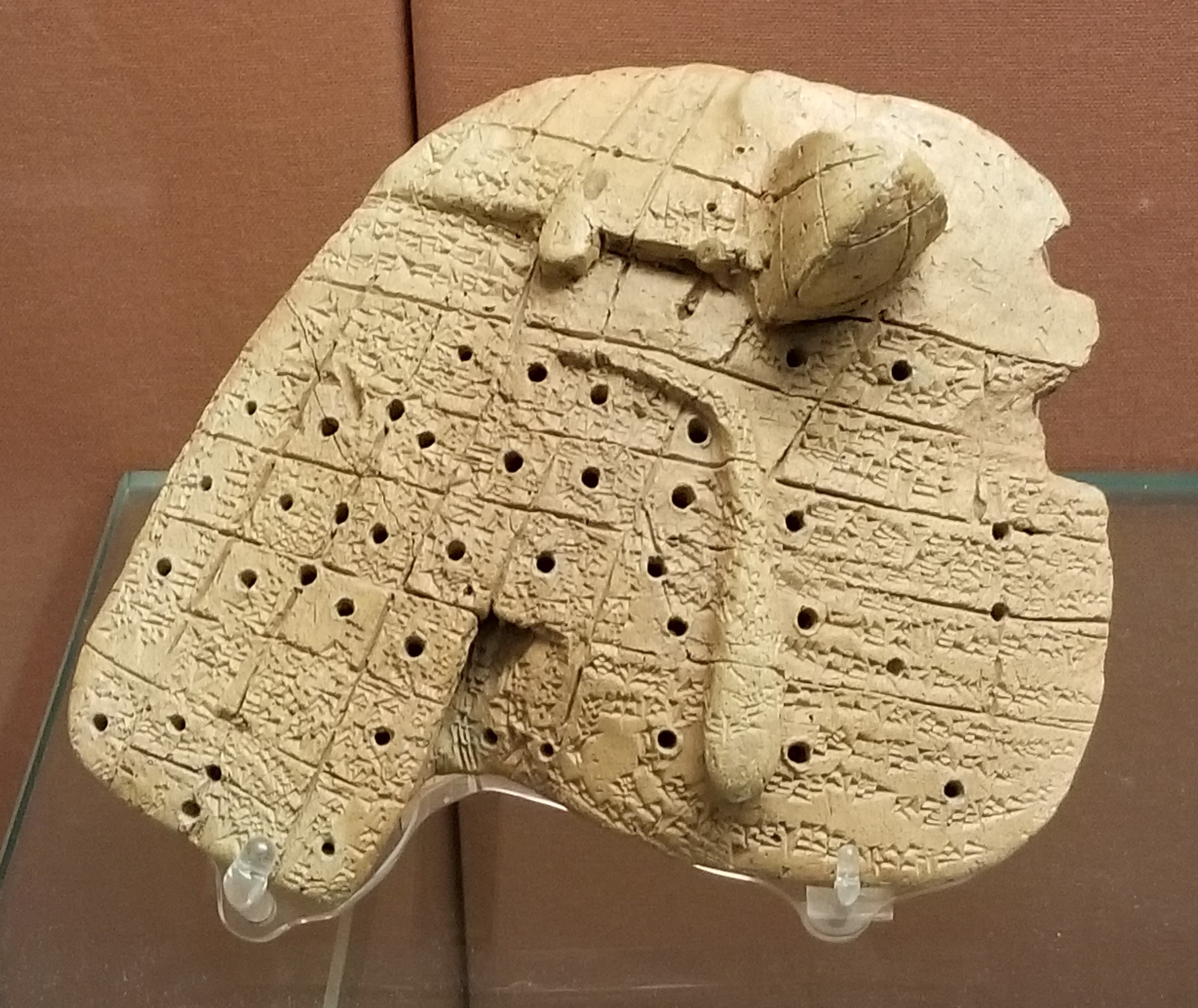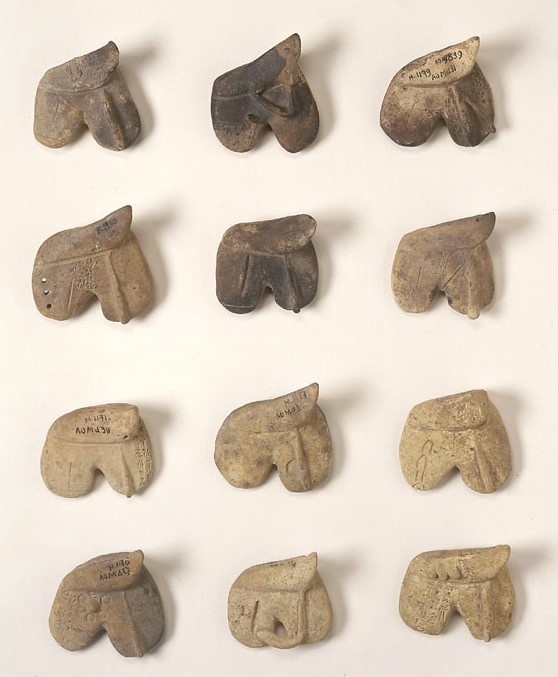Looking in the liver (Continuity of Magic from East to West, Part 2A)
There’s an odd-looking artifact in the Near Eastern section of the British Museum. Made of baked clay, it’s part anatomy lesson and part Battleship grid. Its plaque tells us it’s The Liver Tablet, dated between 1900 and 1600 BCE and found in Sippar (modern Tell Abu Habbah, central Iraq), and describes it thus:¹
Inscribed model of a sheep’s liver probably used for instructing pupils; each box describes the implications of a blemish appearing at that position.

And just what might those implications be? We’re talking here about divination—attempting to foresee the future—the mysterious -mancies ancient magic is riddled with. In this case, it’s hepatomancy, itself is a type of haruspicy. The first term derives from the Greek words for “liver” (ἧπαρ, hêpar) and “divination” (μαντεία), and the second from an archaic Latin word for “entrails” (haru) and the Latin word “to observe” (speciō). Still more terms referring to the same arts appear, and as they will come up later, it’s best to introduce them as well; hepatoscopy (hêpar + σκοπία, skopiá “to examine”) and extispicy (exta, “entrails” + speciō), respectively synonyms of the first pair.
The Brit’s liver tablet turns out to be far from unique, with hundreds of similar ones excavated from sites like Mari (in modern eastern-central Syria) and Hazor (north-eastern Israel), with some 36 found at Ḫattuša (central Turkey) alone.

And of course the reason this object caught my eye is there is a rather famous one that’s quite similar relating to the Roman culture, known as the Liver of Piacenza for the northern Italian province in which it was found, more on which later.

Returning to the ancient Near East (ANE), although several terms for various priests and priestesses are attested, there are a few for this specific religious office, including Sumerian mash’shukitki (𒈧𒋗𒁍𒁍), which came to be expressed in Akkadian as bārû (𒀀𒍪). In the ANE, hepatomancy is thought to be the oldest of the divinatory arts, predating even writing. As professor of ANE studies, Beate Pongratz-Leisten notes:²
While no omen reports have been transmitted from the early periods, Early Dynastic profession lists and numerous administrative tablets from Ebla [in modern northwest Syria] point to the practice of extispicy performed during the third millennium BCE.
The specially trained priests would inspect the liver and lungs of a sacrificial sheep for omens. Much as the heart is today, the liver was regarded as the seat of emotions, especially desire, and even life and the soul, and so received particular emphasis in auguries. As a side note, in antiquity Cupid/ Ἔρως’s arrows targeted neither the victim’s heart nor liver but their eyes—they were that shallow.
Moreover, although anything animate or inanimate could be used by the gods to express their will as to human affairs or indeed cosmic truths, the stars and the liver were thought of as particularly favored media. Professor of religious and classical studies Alan Lenzi notes:³
[Mesopotamian s]cholars’ references to the celestial phenomena as “heavenly writing” (šiṭir šamê) or “writing of the firmament” (šiṭir burūmê), and the categorization of the liver as the “tablet of the gods” (-uppi ša ilī), are indicative of this perspective.
As to the method of this divination, the size, shape, and color of the organ were considered, but marks and the locations in which they appeared were of particular importance. Just as the museum’s label notes, the liver tablet and many like it essentially directed the student to the omen indicated by a mark at a given location.
Prior to all of this, the priest would have a specific question to which the answer was being sought, generally regarding the important actions a ruler was planning to take, in order to gauge both the general cosmic favorability and the possible repercussions. The priest then:⁴
[…] used judicial terminology, asking the sun god Šamaš “to judge the case” (dīna diānu) and “put truth” (kitta šakānu) into the entrails of the sheep.
As this suggests, such auguries mainly pertained to royalty, and as the sheep you possessed essentially equated to your wealth and social status, the extravagance of consulting their innards was also necessarily restricted to the elite. For example, the archive at Ebla, in the northwest of modern Syria, one of the largest from the time and region (mid-third millennium BCE) contained lists of sheep so used, which:⁵
[…] reveal that it was practiced on a large scale on behalf of the court, but also point to the king’s sponsorship and patronage of the craft.
The latter was true to such an extent the seals of these priests beginning in the Old Babylonian period (ca. 1830 BCE) reflected their position in direct relation to the kings they served. One, named Asqudum from the kingdom of Mari, for example, reads:⁶
Zimri-Lim, appointed by the god Dagan; Asqudum, the diviner
Zimri-Lim, is of course, the king he served.
Furthermore, the Book of Ezekiel characterizes Nebuchadnezzar II (𒀭𒀝𒆪𒁺𒌨𒊑𒋀) of the Neo-Babylonian Empire as personally performing hepatomancy among other divinatory arts:⁷
For the king of Babylon stood at the parting of the way, at the head of the two ways, to use divination: he made his arrows bright, he consulted with images, he looked in the liver.
A few things are worth noting here: First, the crossroads is the locus of the oracle, a liminal space in several traditions. The Greek Ἑκάτη (Hekátē) was the goddess of the crossroads and of witchcraft, and the Roman Diana took on these aspects under the epithet Trivia, meaning “triple way”, or crossroads. Ἑρμῆς (Hermes) was also a liminal figure, not only as messenger between gods and mortals, but in his role as ψυχοπομπός (psychopomp), leading the souls of the departed to Ἁιδης (Haides). For this reason, he is another god of the crossroads, under the epithet, Τρικεφαλος (Trikephalos, “3-headed”). This idea of road intersections as magical spaces was passed down even to relatively modern times, as bluesman Robert Jordan was reputed to have traded his soul to the devil for his guitar skills in the 1920s.
Second, the arrows are actually “shaken” rather than “made bright”—other translations render it this way. That is, they are cast as lots. This is another form of divination known as cleromancy.
Finally, the images mentioned are graven ones—idols known as teraphim (תְּרָפִים), “household gods”. All of this was to decide whether to invade Jerusalem, for which apparently the king received a resounding yes from the gods.
From the time divinatory material begins to appear in writing, royal and temple libraries show it to be quite important, often housing large collections. An example of the importance of such documents can be seen in King Ashurbanipal’s archive, where over a quarter of the tablets were divinatory.
These royal associations extended to the omens themselves because of their relationship to historical events, i.e., this mark appeared when king X did Y, and so presenting either dire or propitious tidings based on the outcome. Things like:⁸
a-mu-ut Na-ra-am-(d)Sîn sá A-pí-sá-al Il-qá-é
Omen of Naram-Sin who conquered Apishal.
and
a-mu-ut ú-hu-ra-im si12 I-bí-(d)Sîn ba-taq? ma-ti-šu i-ba-al-ki-li-šu
Omen of diminishment of Ibbi-Sin against whom a fraction of his country made a revolt.
Naram-Sîn and Ibbi-Sîn being kings of the Akkadian (ca. 2334–2154 BCE) and Ur III (ca. 2112–2004 BCE) periods, respectively.
Eventually, and somewhat predictably, it became aspirational to appear in these omens as a paradigmatic and historiographic ruler, also uncoincidentally increasing one’s prestige and political power. Ashurbanipal, for example, sought to insert himself into the company of kings like Sargon and Naram-Sîn of Akkad, as is recorded in a letter from a diviner asking how the king would like his omens to be written, running in part:⁹
[Omen for Assurbani]pal, mighty king, reverent prince, of whom (it is said) Ištar (walks) at the side of his a[rmy] cut off [the head of Teumman, king of Ela]m in the midst of battle and the son of Bēl-iqīsha […]-tuk of the Elamite they hung around his neck, and Assurbanipal [went to Nineve]h, his royal residence. They were exulting joyfully and performed music, the messenger? of Ummanigash, king of Elam, he killed in front of Assurbanipal, king of the universe, and he sat on his throne. Assurbanipal, king of the universe, at the command of […] Tammarītu, king of Elam, together with his magnates rolled before him [in?] Nineveh, his royal residence. [whom Assur and] Ištar love and lead with their full content, and Tammarītu who had plotted for help of Šamaš-šum-ukīn, he himself, the diviner and his magnates went and kissed his feet, Tammarītu and the diviner accused each other in front of him.
[If… the right and left side of the station are […] it is the omen of Assurbanipal, king of the universe, (of whom it is said) that Šamaš and Ištar walk at the side of his army and killed (his enemies) in the midst of battle and effected their defeat.
[If…] in the lift of the head of the right lung there is a sign/omen (predicting) the annihilation of the army, it is an omen of Šamaš-šum-ukīn, [the treacherous brother, who] fought against the army of Assurbanipal, the beloved of the great gods, (but) was defeated.
I’ve covered the prevalence of this form of divination in the ANE, next time more about its presence in Western magic and ritual.
Coincidentally, the Brit’s exhibition, “I am Ashurbanipal: king of the world, king of Assyria”, was really what I went there to see but alas, it was the final weekend of its run, it was sold out, and I didn’t get to see it so I did this instead.
Read subsequent articles in the Continuity of Magic from East to West series
Part 2B: Go West, Young Mantis
Part 3B: Devoted More Than All Others
Part 4A: Romancing the Hellenes
Part 4B: The Chthonian Connection
Part 5: Hellenism, Schmellenism
Part 6: Myth and Magic in the Cultural Koiné
Part 8: No Ewoks, Only the Dead
Read previous articles in the Continuity of Magic from East to West series
Part 1: The Griffin and the Phoenix
Notes
- Object 92668, The Liver Tablet, British Museum, ca. 1900–1600 BCE.
- Beate Pongratz-Leisten, “The King at the Crossroads between Divination and Cosmology”, Divination, Politics, and Ancient Near Eastern Empires, Alan Lenzi & Jonathan Stökl, eds., 2014.
- Alan Lenzi, “Revisiting Biblical Prophecy, Revealed Knowledge Pertaining to Ritual, and Secrecy in Light of Ancient Mesopotamian Prophetic Texts”, Divination, Politics, and Ancient Near Eastern Empires, Alan Lenzi & Jonathan Stökl, eds., 2014.
- Pongratz-Leisten, 2014.
- Ibid.
- Dominique Charpin, “Patron and Client: Zimri-Lim and Asqudum the Diviner,” The Oxford Handbook of Cuneiform Culture, 2011.
- Ezek. 21:21, King James Version (KJV), 1611.
- RA 35, nos. 3 and 6, quoted in Pongratz-Leisten, 2014.
- RM 2, 455, quoted in ibid.